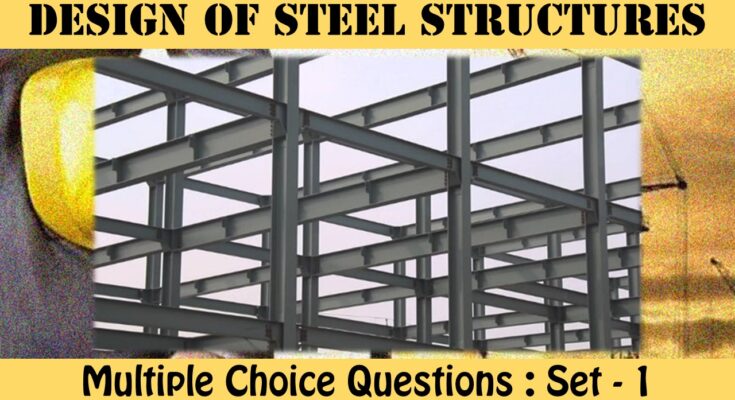MCQ Questions Civil Engineering Design of Steel Structures
The interviewer is almost as nervous as the candidate in most interviews. You might wonder if you look confident enough, if you will hire the right person, or if you are asking the right engineering interview questions. The last question is arguably the most crucial part to worry about when you’re interviewing candidates. Other topics on Civil Engineering Multiple Choice Questions can be accessed
MCQ Questions Civil Engineering Design of Steel Structures - Set - 1
Question 1:
If the thickness of plate to be connected by a rivet is 16 mm, then suitable size of rivet as per Unwin’s formula will be
a) 16 mm
b) 20 mm
c) 24 mm
d) 27 mm
Correct Answer – (C)
Question 2 :
The difference between gross diameter and nominal diameter for the rivets up to 25 mm diameter is
a) 1.0 mm
b) 1.5 mm
c) 2.0 mm
d) 2.5 mm
Correct Answer – (B)
Question 3 :
When the axis of load lies in the plane of rivet group, then the most heavily loaded rivet will be the one which
a) is at the maximum distance from CG of the rivet group
b) is at the minimum distance from CG of the rivet group
c) gives the maximum angle between the two forces Fa and Fm
d) gives the minimum angle between the two forces Fa and Fm
where, Fa is the load shared by each rivet due to axial load and Fm is the shearing load due to moment in any rivet.
Correct Answer – (D)
Question 4 :
In a gusseted base, when the end of the column is machined for complete bearing on the base plate, then the axial load is assumed to be transferred to base plate
a) fully by direct bearing
b) fully through fastenings
c) 50% by direct bearing and 50% through fastenings
d) 75% by direct bearing and 25% through fastenings
Correct Answer – (C)
Question 5 :
Bending compressive and tensile stresses respectively are calculated based on
a) net area and gross area
b) gross area and net area
c) net area in both cases
d) gross area in both cases
Correct Answer – (B)
MCQ Questions Civil Engineering Design of Steel Structures
Question 6:
As compared to field rivets, the shop rivets are
a) stronger
b) weaker
c) equally strong
d) any of the above
Correct Answer – (A)
Question 7:
Which of the following types of riveted joint is free from bending stresses ?
a) lap joint
b) butt joint with single cover plate
c) butt joint with double cover plates
d) none of the above
Correct Answer – (C)
Question 8:
When the axis of load lies in the plane of rivet group, then the rivets are subjected to
a) only shear stresses
b) only tensile stresses
c) both (a) and (b)
d) none of the above
Correct Answer – (A)
Question 9:
If the thickness of thinnest outside plate is 10 mm, then the maximum pitch of rivets in tension will be taken as
a) 120 mm
b) 160 mm
c) 200 mm
d) 300 mm
Correct Answer – (B)
Question 10:
The heaviest I-section for same depth is
a) ISMB
b) ISLB
c) ISHB
d) ISWB
Correct Answer – (C)
- NCERT Solutions Class 12 Mathematics RD Sharma Sets : Exercise 1.1
- NCERT Solutions Class 12 Mathematics RD Sharma Sets : Exercise 1.2
- NCERT Solutions Class 12 Mathematics RD Sharma Sets : Exercise 1.3
- NCERT Solutions Class 12 Mathematics RD Sharma Sets : Exercise 1.4
- NCERT Solutions Class 12 Mathematics RD Sharma Trigonometric Functions : Exercise – 5.1
- NCERT Solutions Class 12 Mathematics RD Sharma Trigonometric Functions : Exercise – 5.2
- NCERT Solutions Class 12 Mathematics RD Sharma Trigonometric Functions : Exercise – 5.3
- NCERT Solutions Class 12 Mathematics RD Sharma Quadratic Equations : Exercise – 14.1
- NCERT Solutions Class 12 Mathematics RD Sharma Quadratic Equations : Exercise – 14.2
- NCERT Solutions Class 12 Mathematics RD Sharma Linear Inequations : Exercise – 15.1
- NCERT Solutions Class 12 Mathematics RD Sharma Linear Inequations : Exercise – 15.2
- NCERT Solutions Class 12 Mathematics RD Sharma Linear Inequations : Exercise – 15.3
- NCERT Solutions Class 12 Mathematics RD Sharma Linear Inequations : Exercise – 15.4
- NCERT Solutions Class 12 Mathematics RD Sharma Linear Inequations : Exercise – 15.5
- NCERT Solutions Class 12 Mathematics RD Sharma Linear Inequations : Exercise – 15.6
Multiple Choice Questions for Competitive Exams
- Multiple Choice Questions Class 12 Chemistry The Solid State
Set -1 Set -2 Set -3 Set -4 Set -5 - MCQ Questions Class 12 Solutions With Answers
Set -1 Set -2 Set -3 Set -4 Set -5 - MCQ Questions Class 12 Electrochemistry With Answers
Set -1 Set -2 Set -3 Set -4 Set -5 - MCQ Questions Class 12 Chemical Kinetics With Answers
Set -1 Set -2 Set -3 Set -4 Set -5 - MCQ Questions Class 12 Surface Chemistry With Answers
Set -1 Set -2 Set -3 Set -4 Set -5 - MCQ Questions Class 12 General Principles and Processes of Isolation of Elements With Answers
Set -1 Set -2 Set -3 Set -4 Set -5




